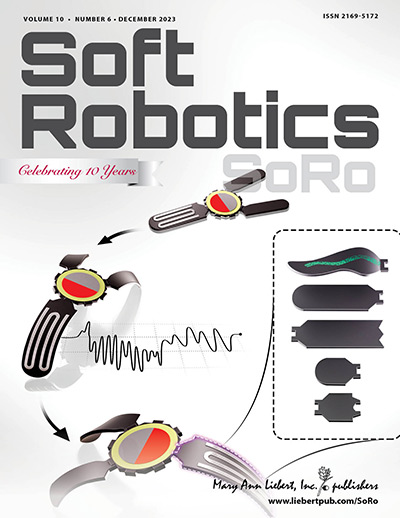Improving the Efficiency of Soft Phase-Change Actuators Using Thermodynamic Analysis.
IF 6.1
2区 计算机科学
Q1 ROBOTICS
引用次数: 0
Abstract
Actuation is a key challenge for the field of soft robotics. One method of actuation, thermally driven liquid-to-vapor phase change heat engines, is particularly compelling due to its high forces, large strokes, and relative simplicity. However, this form of actuation suffers from a very low efficiency, making its impact for practical applications limited. Here we apply thermodynamic analysis to these phase-change actuators to identify major inefficiencies and offer three key insights that soft roboticists can leverage to improve efficiency: (1) maximize the ratio of input power to heat loss, (2) operate at an intermediate temperature, and (3) maximize volumetric expansion. We confirm the validity of these insights via benchtop experiments and show efficiencies nearly two orders of magnitude higher than previously reported. We demonstrate the usefulness of these insights by applying them to the design and construction of a compliant roller powered directly by sunlight and capable of rolling every 16 s. Our results guide the design of more efficient phase-change actuators for soft robots and more generally, demonstrate the potential of applying thermodynamic analysis to improve the efficiency of soft actuators.利用热力学分析提高软相变执行器的效率。
驱动是软机器人领域的一个关键挑战。一种驱动方法,热驱动液-气相变热机,由于其强大的力量,大冲程和相对简单而特别引人注目。然而,这种驱动形式的效率非常低,使其对实际应用的影响受到限制。在这里,我们将热力学分析应用于这些相变执行器,以确定主要的低效率,并提供软机器人专家可以利用的三个关键见解来提高效率:(1)最大限度地提高输入功率与热损失的比例,(2)在中间温度下运行,(3)最大限度地提高体积膨胀。我们通过台式实验证实了这些见解的有效性,并显示出比之前报道的效率高出近两个数量级。我们通过将这些见解应用于直接由阳光驱动并能够每16秒滚动一次的柔性滚筒的设计和构造来证明这些见解的有用性。我们的研究结果指导了更高效的软机器人相变执行器的设计,更广泛地说,展示了应用热力学分析来提高软执行器效率的潜力。
本文章由计算机程序翻译,如有差异,请以英文原文为准。
求助全文
约1分钟内获得全文
求助全文
来源期刊

Soft Robotics
ROBOTICS-
CiteScore
15.50
自引率
5.10%
发文量
128
期刊介绍:
Soft Robotics (SoRo) stands as a premier robotics journal, showcasing top-tier, peer-reviewed research on the forefront of soft and deformable robotics. Encompassing flexible electronics, materials science, computer science, and biomechanics, it pioneers breakthroughs in robotic technology capable of safe interaction with living systems and navigating complex environments, natural or human-made.
With a multidisciplinary approach, SoRo integrates advancements in biomedical engineering, biomechanics, mathematical modeling, biopolymer chemistry, computer science, and tissue engineering, offering comprehensive insights into constructing adaptable devices that can undergo significant changes in shape and size. This transformative technology finds critical applications in surgery, assistive healthcare devices, emergency search and rescue, space instrument repair, mine detection, and beyond.
 求助内容:
求助内容: 应助结果提醒方式:
应助结果提醒方式:


